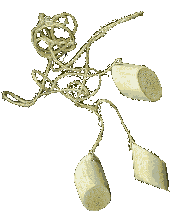
A Bola was primarily a hunting weapon used by many aboriginal peoples throughout the Americas in the past. While those in the south may have made their Bolas from a range of local materials, the Inuit made theirs from sinew and bones. The Bola was whirled overhead and thrown at an animal's legs to entangle the legs and prevent the animal from running. No longer used for hunting purposes by aboriginal peoples, it is still found in use, at times, by the Gauchos who herd cattle in southern South America.
The photo illustrates one of the Inuit Bolas in the collection. It was purchased in 1973 from an Arctic cooperative, which called it Kiipooyaq. When extended to it's full length it is 22cm long. The three pieces of slant cut bones each have a hole on one end and are suspended from a piece of braided hemp tied through the hole. The three pieces of hemp are tied together at the other ends into a loop which is used as a kind of handle.

This second photo (right) of a Bola, purchased by the in 1979, is made of two bones approximately 4.8cm long x 3cm wide x 1.3cm thick. A small hole is bored in the narrow ends of each bone, and a piece of braided hemp is tied into each hole. The other two ends of the hemp is knotted together making the length of the object 86.5cm.
Two methods of play for this equipment appear to exist. In the first method, a target such as a piece of wood is suspended and the Bola is whirled around and aimed at the target. The second method is an entirely different game call Chuk Chuk on Holman Island (western Artic). In this method a player holds the tied ends of the hemp in one hand, and the bones in the other hand. Then letting go of one piece of bone, the hand holding the hemp swings that bone in a clockwise direction. When ready, the player lets go of a second piece of bone, sending it in a counter clockwise direction while maintaining the direction of the first piece of bone. Finally, in the three bone version, the third piece is dropped and all three must move in their own arcs without interfering with each other. The winner is the player who can do this. To complicate the game various body positions are taken, such as maintaining the movement above a player's head, or holding the hemp knotted end in the teeth and moving the head up and down. (F.H. Eger, Eskimo Inuit Games, Vancouver: X-Press, page 108.)
Last update June 20, 2010